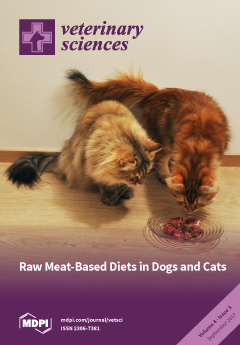The prevalence of intestinal parasites and vector-borne agents of dogs and cats in the Pine Ridge Reservation, South Dakota were determined. Fecal samples (84 dogs, 9 cats) were examined by centrifugal floatation and by immunofluorescence assay (FA) for
Giardia and
Cryptosporidium. PCR
[...] Read more.
The prevalence of intestinal parasites and vector-borne agents of dogs and cats in the Pine Ridge Reservation, South Dakota were determined. Fecal samples (84 dogs, 9 cats) were examined by centrifugal floatation and by immunofluorescence assay (FA) for
Giardia and
Cryptosporidium. PCR was performed on
Giardia [beta-giardin (bg), triose phosphate isomerase (tpi), glutamate dehydrogenase genes (gdh)] and
Cryptosporidium [heat shock protein-70 gene (hsp)] FA positive samples. Cat sera (
n = 32) were tested for antibodies against
Bartonella spp.,
Toxoplasma gondii, and FIV, and antigens of FeLV and
Dirofilaria immitis. Dog sera (
n = 82) were tested for antibodies against
T. gondii,
Borrelia burgdorferi,
Ehrlichia canis, and
Anaplasma phagocytophilum and
D. immitis antigen. Blood samples (92 dogs, 39 cats) were assessed by PCR for amplification of DNA of
Bartonella spp.,
Ehrlichia spp.,
Anaplasma spp., haemoplasmas, and
Babesia spp. (dogs only). The most significant results were
Giardia spp. (32% by FA),
Taenia spp. (17.8%) and
Cryptosporidium spp. (7.1%). The
Giardia isolates typed as the dog-specific assemblages C or D and four
Cryptosporidium isolates typed as
C. canis. Antibodies against
T. gondii were detected in 15% of the dogs. Antibodies against
Bartonella spp. and against
T. gondii were detected in 37.5% and 6% of the cats respectively. FeLV antigen was detected in 10% of the cats.
Full article






